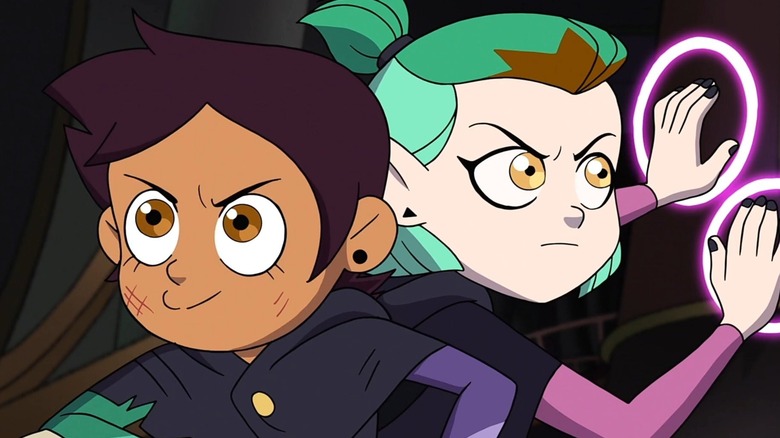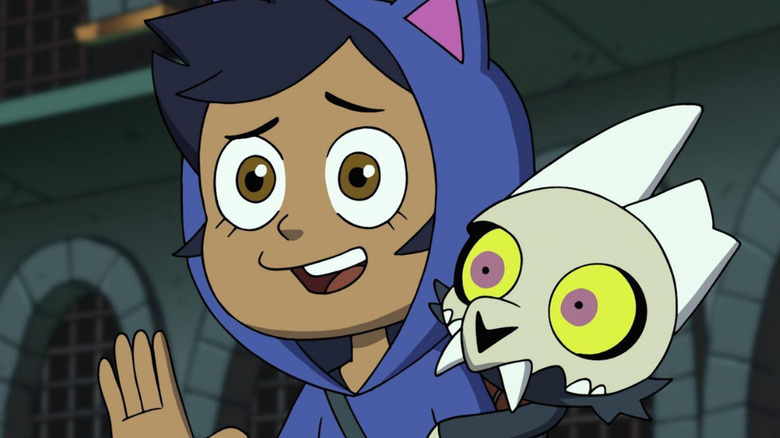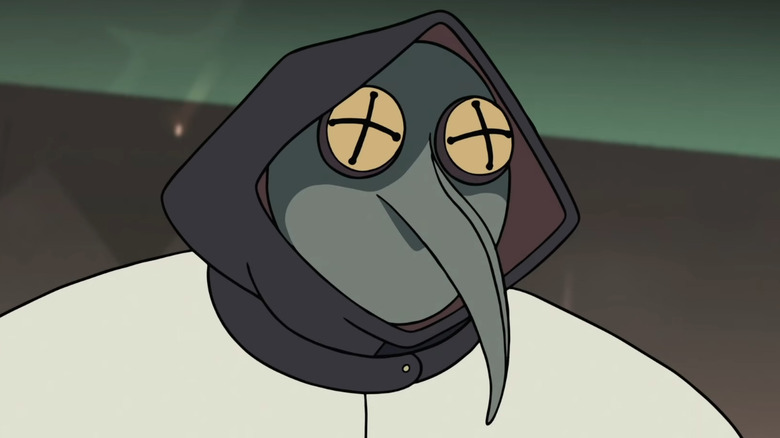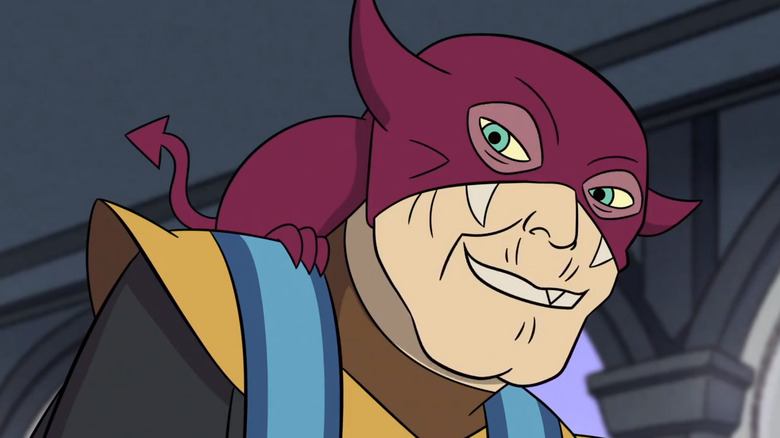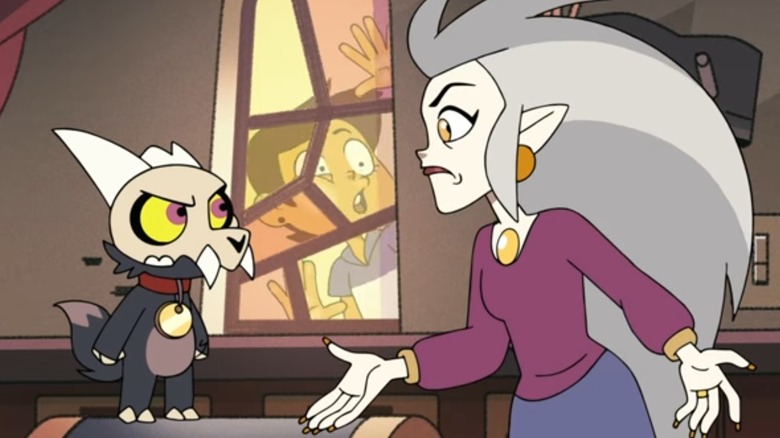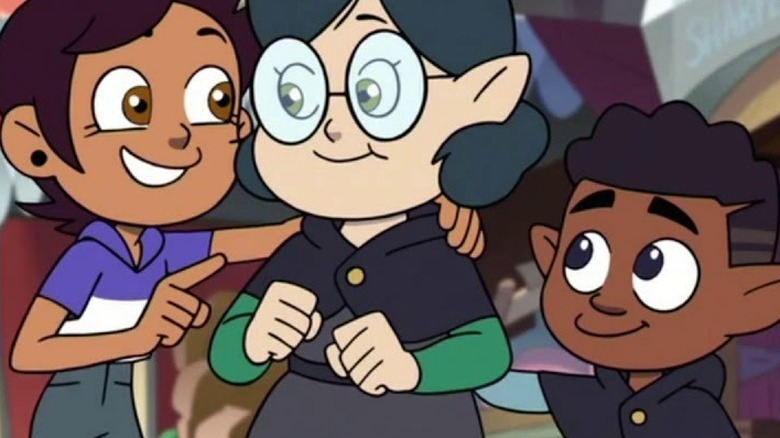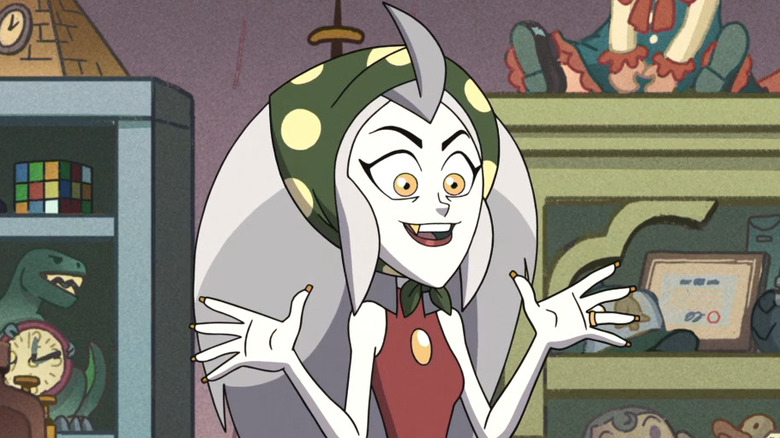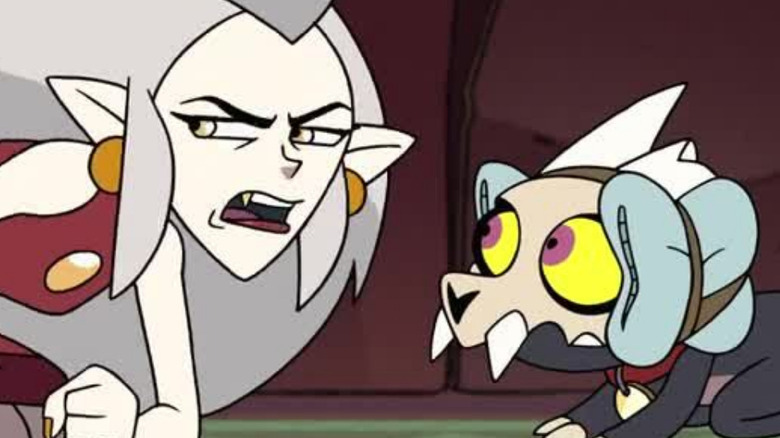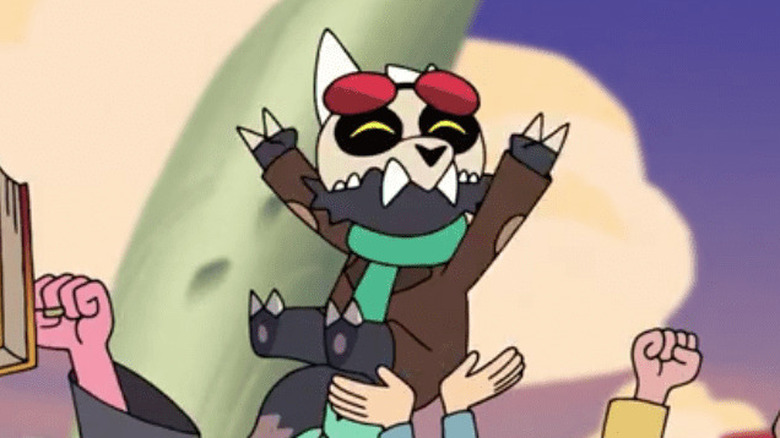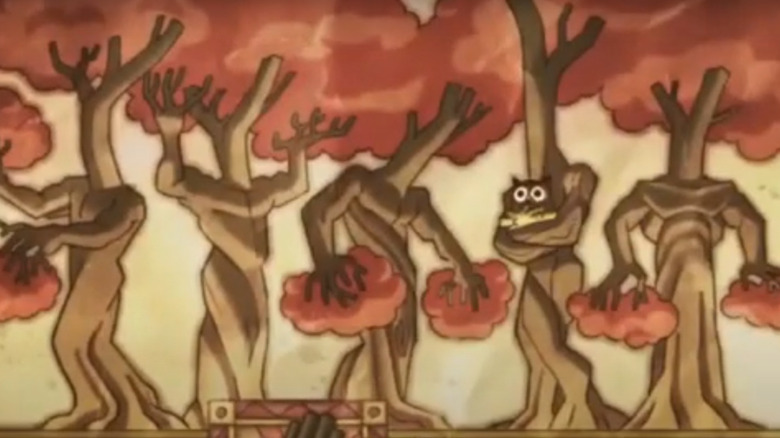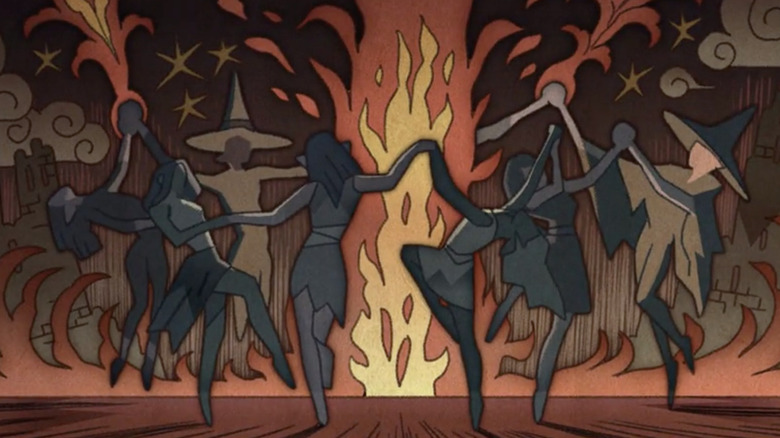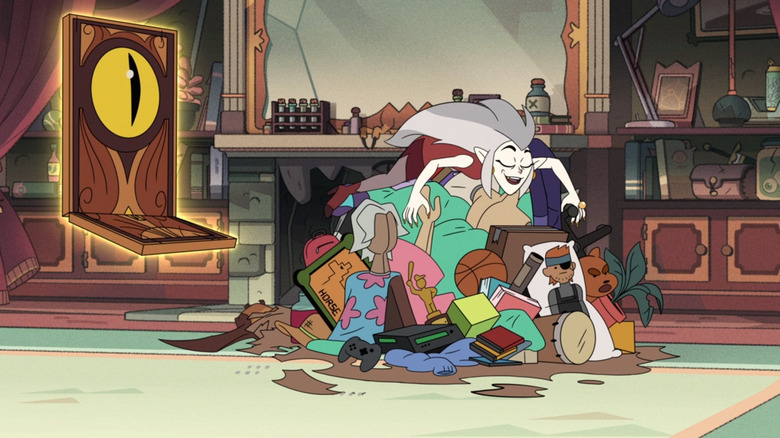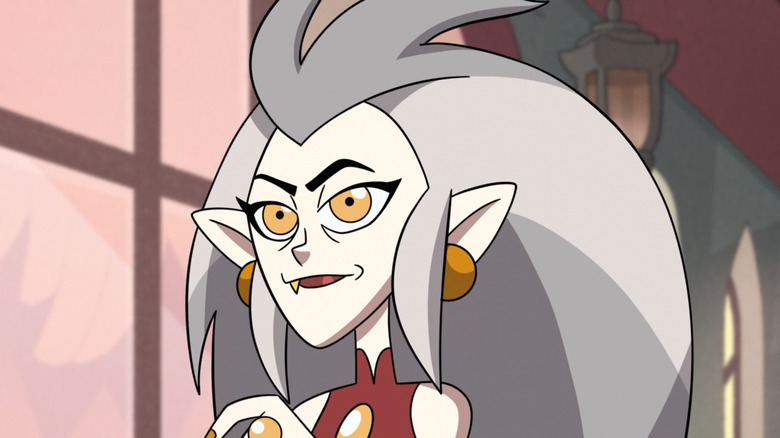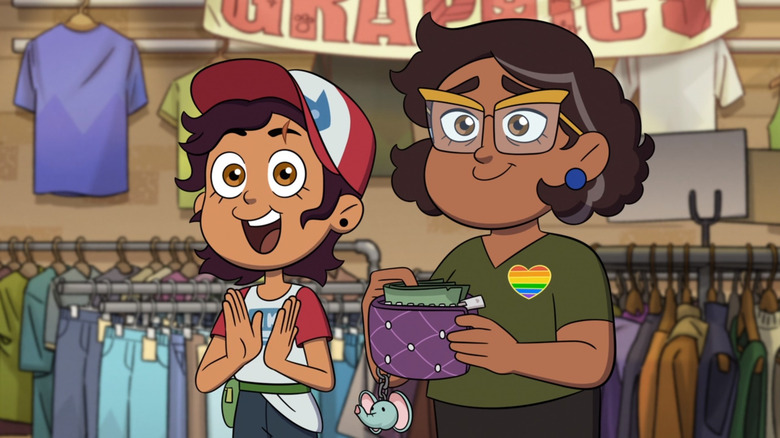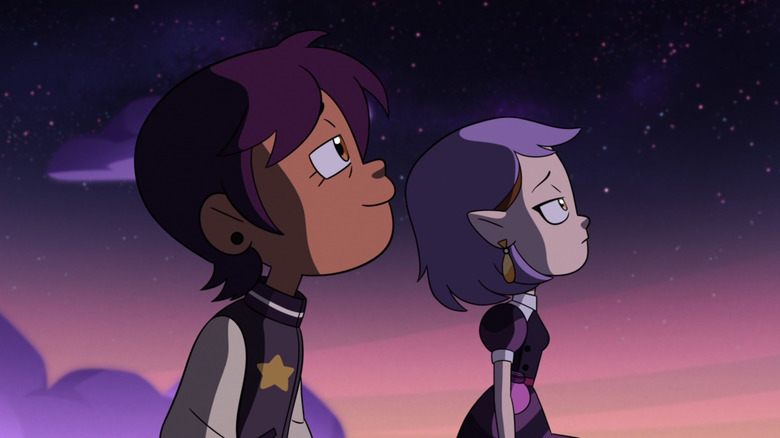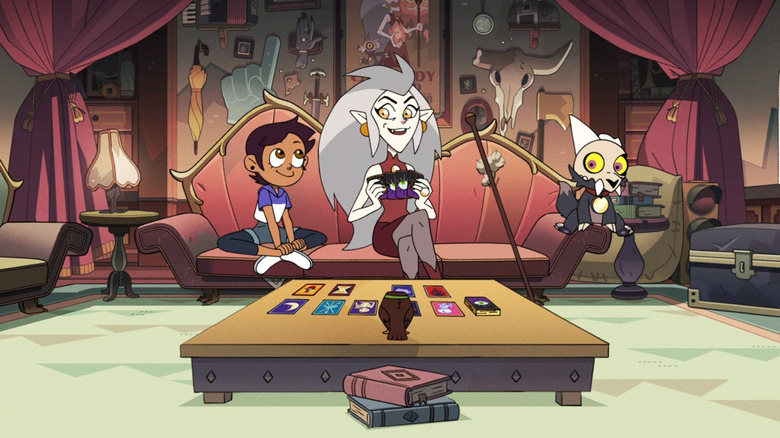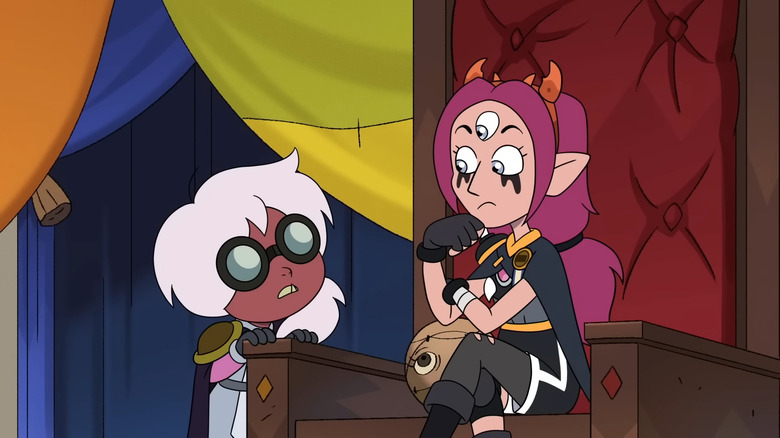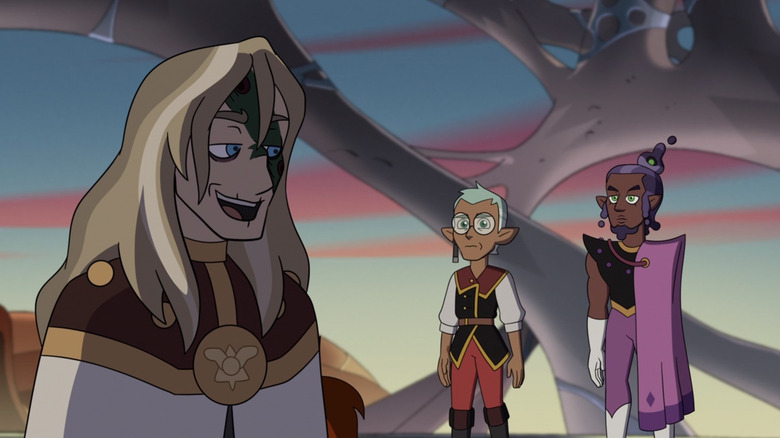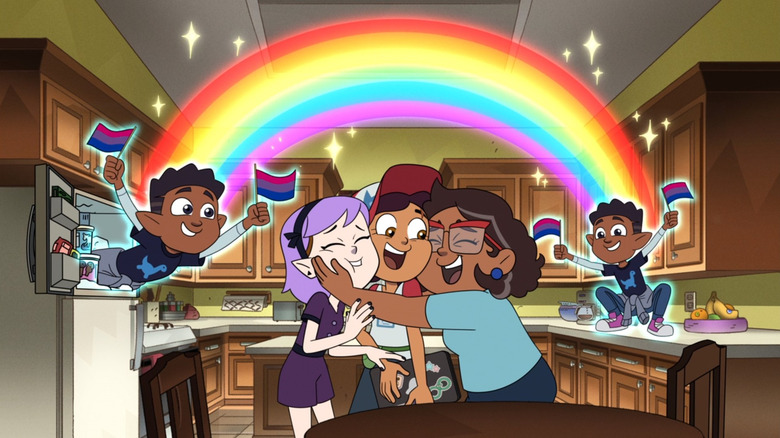Things Only Adults Notice In The Owl House
"The Owl House" follows Luz Noceda (Sarah-Nicole Robles), a fantasy-obsessed teenager sent to a disciplinary summer camp by her concerned mom. Her plans change dramatically when she accidentally stumbles upon a portal to another world. There, Luz meets Edalyn Clawthorne, the Owl Lady (Wendie Malick), a rebellious witch on the run from the law. She also meets Eda's companion demon, King (Alex Hirsch), and promptly befriends them both.
Through some serious persuasion, Luz convinces Eda to teach her magic. This is unprecedented — as Luz is told over and over again, humans can't do magic. But Luz is determined to prove everyone wrong. As the series winds on, Luz befriends other teen witches, establishes a rivalry with a powerful peer, and becomes a pillar in Eda's tiny inner circle.
Although "The Owl House" is aimed at kids, there are several moments aimed at any adults who might be watching along. These are the things only adults notice in "The Owl House," from its Bob Dylan references to the Emperor's eye-popping topiary.
Luz asks if she's in the bad place
After she stumbles through the portal in Episode 1, "A Lying Witch and a Warden," Luz asks, "Am I in the bad place?" Any adult in the room will get a chuckle out of this — it's not often a cartoon character on the Disney Channel wonders if she's receiving divine punishment. This question will also be familiar to fans of NBC's "The Good Place," a series aimed at a very different audience than that of "The Owl House."
"The Good Place" explores a social experiment conducted in the afterlife, in which a group of morally reprehensible people are made to believe they've gone to Heaven, a.k.a. "the good place." They slowly discover they've been in the bad place all along, and work to overcome their eternal fate. The show continues to play with perception and reality for the rest of its tenure.
It seems unlikely that kids or even teens watching "The Owl House" will have seen "The Good Place," since it plays with some pretty grown-up themes. But adults watching this animated show will certainly spot the reference.
Warden Wrath is a plague doctor
When Luz meets Eda in "The Owl House, she's shocked to discover she's a witch — and she's even more surprised to learn that Eda is a wanted criminal. A prison guard attempts to arrest Eda at her market stand, stating that she is wanted for "misuse of magic and demonic misdemeanors." He attempts to take Eda and Luz to the Conformatorium, which is this realm's version of a high-security penitentiary. Eda isn't so easily arrested, though, and she and Luz make a narrow escape.
Eventually, they do end up at the Conformatorium, in order to retrieve a crown belonging to King. There, they encounter Warden Wrath, whose design is eerily similar to a historical plague doctor. Although cultural opinion on plague doctors varies, they are often seen as omens of death and disease. In "The Owl House," predatory Warden Wrath won't take "no" for an answer when Eda rejects him. He might not be unpleasant because of his association with bubonic plague, but he definitely inspires the same sort of unease. Adults who grasp the association will be extra creeped out.
Principal Bump is a classic art reference
In Eda's world, young witches and warlocks are educated at Hexside School of Magic and Demonics, which is a major setting in "The Owl House." The head of the school is Principal Hieronymus Bump. As art-savvy adults will notice, his name is a reference to Dutch painter Hieronymus Bosch. Bosch is perhaps most famous for the triptych "The Garden of Earthly Delights," which he painted around the turn of the 16th century. This piece depicts both the Garden of Eden and the Last Judgment. The Last Judgment panel features all kinds of terrifying creatures, including strange demons mingling mysteriously with humans.
In "The Owl House," Principal Bump wears a hat that covers his eyes. The garment looks like a small, red demon with an open mouth that encapsulates Bump's head. It is unclear if Bump's own eyes see through the sockets in the demon's face, or if the demon sees for Bump, implying a deeper sort of connection. Regardless, the character would be right at home in the far right panel of Bosch's "The Garden of Earthly Delights."
Eda sells literal snake oil
For centuries, self-proclaimed healers sold "snake oil" that claimed to solve any number of health problems. The term has since become synonymous with treatments that aren't scientifically backed and might provide a placebo effect, but not much else. "The Owl House" puts its own twist on this bizarre tidbit of medical history that adults are sure to chuckle at.
After agreeing to take Luz on as an apprentice, Eda reveals that her magical practice is less education-focused and more centered on, well, making money. She shows Luz a few of the items she sells in her various "businesses," including a bottle of snake oil. "No one wants an unoiled snake," Eda proclaims, which paints a funny picture audience members of any age can enjoy. However, adults who've heard the term used more sneeringly will get an extra laugh out of it. It's a clever literalization of a common phrase, and it establishes Eda as a bit of a con woman. Of course she sells snake oil.
Several episode titles reference classic songs or movies
"The Owl House" features tons of pop culture references, especially in its episode titles. For example, the pilot is called "A Lying Witch and a Warden," which is a play on the beloved C.S. Lewis novel "The Lion, the Witch and the Wardrobe." Another example is Season 1's "Hooty's Moving Hassle." The episode itself follows Luz and her friends Willow (Tati Gabrielle) and Gus (Issac Ryan Brown) as they attempt to beat Luz's rival, Amity (Mae Whitman), by having the best Moonlight Conjuring ever. Things get out of hand when the kids make Eda's house grow legs and walk around. The episode title and content are an obvious reference to "Howl's Moving Castle," which is both a 1986 novel by Diana Wynne Jones and a 2004 animated movie from Studio Ghibli.
References in episode titles continue to be a feature throughout the series. Season 1, Episode 11 is titled "Sense and Insensitivity," referencing the Jane Austen novel "Sense and Sensibility." Season 2, Episode 8 is titled "Knock, Knock, Knockin' on Hooty's Door," which references Bob Dylan's classic ballad, "Knockin' on Heaven's Door." Other episode titles, like "Something Ventured, Someone Framed" and "Witches Before Wizards" invoke clichés like "nothing ventured, nothing gained" and variations on "hoes before bros."
Satirizing the gig economy
"The Owl House" isn't afraid to satirize society — just look at the way it critiques the economic strictures of the modern world. Eda's multiple small businesses reflect the difficulties of surviving in a "gig economy," and episodes like Season 1's "Once Upon a Swap" focus on how ridiculous consumerism can be. In the latter episode, Eda, King and Luz all swap bodies to prove who has the hardest life. Of course, shenanigans ensue, but when Luz-as-Eda accidentally breaks a lamp and uses magic to fix it, she creates a multi-light fixture with real human legs. Picture a more grotesque version of the infamous leg lamp from "A Christmas Story."
Immediately, a customer runs up and calls the lamp "unnecessarily extravagant" ... then purchases it. After it sells, Luz starts using magic on all the "human collectibles" in Eda's booth, and customers swarm. The commentary is razor-sharp: The more absurd an item is, the more people want it — which "The Owl House" suggests isn't necessarily a good thing.
King suggests inventing the Disney Channel to entertain kids
Disney is one of the largest media companies in the world, so naturally, its properties occasionally get meta. In Season 1's "Lost in Language," Eda and King find a basketful of bat babies on the doorstep, along with instructions to watch them until morning. In exchange, they'll receive a handsome reward from the Bat Queen herself, which they just can't pass it up. However, babysitting wreaks havoc on Eda, King, and Hooty, all of whom are ill-equipped to handle children — especially ones that can apparently clone themselves.
At one point, King asks, "What silences children? What if we invent a TV network for ages 6-11?" Eda shoots down the idea, but he's definitely onto something. The Disney Channel itself is, of course, aimed at kids within that very age bracket. And it's definitely successful — King and Eda wouldn't exist without it! This is one self-referential gag adults — especially those with kids who watch nothing but the Disney Channel — definitely appreciate.
King's publisher forces creative burnout
After Luz enlists King to help her write a book for a contest in Season 1's "Sense and Insensitivity," the pair discover they don't see eye to eye on the creative process. To make matters worse, King decides to take all the credit for their shared work and becomes a best-selling author. Immediately, his publisher begins pushing him to write a new book, and the quality diminishes significantly. "The Owl House" uses this plot line to comment on the predatory nature of certain industries, and also call out the dangers of creative burnout. When Luz confronts the publisher for his borderline abusive behavior, it's a win for creative professionals everywhere.
The serious undertones of this plot are likely lost on kids watching "The Owl House," but adults in the audience — especially any working in a field like publishing — will be struck by how well the series handles these topics. Not only does this episode tackle plagiarism, it also examines how talented people can be mined for content, then left to rot if they can't keep up with unceasing demand.
The Emperor's castle features hunky trees
When Willow and Gus try to convince Luz to go on the field trip to the Emperor's castle in Season 1's "Agony of a Witch," they break out a brochure to show her what she'll be missing if she stays behind. Willow points out the Emperor's collection of relics, including one called the Green Thumb Gauntlet. According to the brochure, this allows the user to grow anything they can imagine — including trees that look like buff, naked human bodies, apparently.
This is quite the eye-catching moment, but it happens pretty fast. Aside from Luz squinting at the page, none of the kids react to the shape of the trees, and Gus moves onto the next thing in the brochure immediately. Either these trees are commonplace in the magical realm, or the creators of "The Owl House" knew very well they were making a cheeky joke. Either way, it's hard to unsee.
References to the Salem Witch Trials
"The Owl House" is all about magic and witchcraft, but it doesn't ignore the controversial real-life history of these subjects. In fact, it satirizes witch hunts, with Eda commenting at one point that "witches eating babies is so 1693" — a.k.a., when the Salem Witch Trials were happening. Later, when Luz goes on a field trip to the Emperor's castle, she sees a painting that depicts several witches dancing around a fire at night. This is exactly the kind of imagery used to persecute women for allegedly cavorting with the devil.
This isn't the only way "The Owl House" interacts with stereotypes about witches. Eda herself flies in the face of most of them, while Luz confronts in-world ideas about what a witch can be, as a human who learns to use magic. Furthermore, the magic system in "The Owl House" is a lot less rooted in dancing with demons in the woods than it is in the realities of our own world. Hexside students follow specific tracks to learn and use certain types of magic, and though some are able to join the Emperor's Coven and use any kind of magic they want, many are not. Just as the series mocks predatory industries and the gig economy, it also examines problematic fantasy lore and the real-world impact of witch trials.
Multiple PlayStation 1 references
Clearly, someone who works on "The Owl House" had a PlayStation 1 as a kid, because the show is littered with references to Sony's debut gaming console. In Episode 2 of the series, "Witches Before Wizards," Luz embarks on a strange adventure with a hunky warrior named Nevareth, who ends up being an illusion. However, before this sad revelation, Luz becomes pretty enamored with him — especially after he asks her the swoon-inducing question, "Do you think love can bloom on the battlefield?" This is a direct nod to the PS1 video game "Metal Gear Solid," in which the character Otacon asks lead protagonist Solid Snake the same infamous question. It's one of the franchise's most well-known and meme-able lines, and fittingly, Nevareth has an eyepatch like many incarnations of Snake.
Half a season later in "Adventures in the Elements," Solid Snake makes an even more overt cameo via one of Eda's treasure hauls from the human realm. The first scene shows her dump out a pile of soon-to-be-sold goodies, including a body pillow with Snake's likeness emblazoned upon it. In yet another Season 1 episode, "Enchanting Grom Fright," Luz is presented with a rack of weapons to choose from for her upcoming battle with Grom. Most of the options are general medieval fare, but one stands out: a perfect replica of the iconic Buster Sword from "Final Fantasy VII," another PS1 classic.
Eda's curse is an analogy for chronic illness
Like many fantasy stories aimed at younger audiences, "The Owl House" explores a lot of its more serious themes through analogy and metaphor. One such example is Eda's curse, which can be read in a number of different ways. Perhaps most notably, Eda's condition parallels real-world chronic health conditions and STIs.
While Eda is unable to find a way to permanently cure her curse, she emphasizes repeatedly that she can manage it with the help of her potions. Combined with a recurring storyline in the early parts of the show in which Eda tries to figure out who "gave" her the malady, this curse specifically sounds a lot like an STI. Eda's family treats her curse like an all-consuming thing, and it's clearly stigmatized in the world of the Boiling Isles. But she shows repeatedly that it can be managed, and that it doesn't define her.
Of course, the analogy doesn't map perfectly, since it's Eda's sister Lilith who curses her in the first place. It might make more sense, then, to interpret Eda's curse as a broader metaphor for chronic illness. Numerous viewers have discussed this reading at length, analyzing how Eda's struggle to accept her condition mirrors the journey many people in the real world experience. Of course, for younger fans, the curse likely reads as just a curse.
Camila is a Trekkie
Much of "The Owl House" centers around Luz accepting her quirks as things to be proud of, rather than ashamed. As a nerdy girl with a predilection for the macabre, she faces bullying and pressure to conform. Early on, her mother Camila seems to also want Luz to be more "normal." But we learn later that her feelings are more complicated than they seem.
In the Season 3 episode "Thanks to Them," we learn that Camila was also bullied for being nerdy as a kid, and that she never fully grew out of it. Gus discovers a science fiction novel in Camila's basement entitled "Cosmic Frontier." Though it was apparently published in the 1990s, it's clearly meant as an homage to older sci-fi franchises from the '60s and '70s. The story of human space travelers trying to find their way home specifically evokes the original "Battlestar Galactica," an early hub of sci-fi fandom. There are numerous nods to "Star Trek" as well. Captain Avery seems like a clear parallel for Captain Kirk, and Chief Engineer O'Bailey is an obvious reference to the Enterprise's Scottish engineer Montgomery "Scotty" Scott.
These are more than clever references, though. By invoking "Star Trek," the show that practically created modern fandom as we know it, "The Owl House" engages with all the ways nerd culture has evolved over the years. This show has always been in conversation with fan culture, and making Luz's mom a Trekkie fits perfectly within that metatextual layer.
Luz struggles with her mental health
Luz is a quirky, lovable, and generally optimistic protagonist. However, as the story continues, there are numerous clues that Luz isn't nearly as happy as she seems. In the "Owl House" Season 2 episode "Reaching Out," Luz tells Amity that it's the anniversary of her father's death. Being away from her mom on this day is particularly hard, but Luz downplays her grief. "It happened, like, a long time ago, and it's, like, totally not an issue anymore," she says. Clearly that's not true, but Luz refuses to accept the validity of her own feelings. Later on, in Season 3, Luz shows an incredible amount of guilt over what's happened to Eda, King, and her other friends. She blames herself, even though it's clearly not her fault and no one else holds her accountable.
These moments can be read as signs of what's sometimes called "smiling depression." Luz doesn't want to burden other people with her feelings, despite the fact that her loved ones clearly want to help her. "She's so determined to make herself sad," Camila says of Luz in the Season 3 episode "For the Future." Luz's story is all about learning to love yourself, but doing so isn't always easy. Fortunately, she has a great support network to help her.
If you or someone you know needs help with mental health, please contact the Crisis Text Line by texting HOME to 741741, call the National Alliance on Mental Illness helpline at 1-800-950-NAMI (6264), or visit the National Institute of Mental Health website.
Eda's many vices
Eda the Owl Lady is a witch of exotic tastes. She's a fierce believer in the gig economy, anti-establishment philosophy, and flipping items found in the garbage. She also has a few more adult vices, the significance of which may go over the heads of younger viewers.
To start, there's Eda's favorite beverage: apple blood. Not to be confused with apple juice, this mysterious drink is difficult to fully understand with what the show has revealed. On the one hand, it seems akin to coffee, as Eda seems lethargic in the mornings before having her first cup. However, there are also clear parallels to alcohol, as Eda views the drink as a kind of relaxant at other times of day. In the Season 3 episode "Thanks to Them," we see that Gus has mentioned apple blood to Camila, saying that she can get it from an "apple butcher" (yikes). This suggests that the drink is appropriate for children, though that may just be a witch thing.
In the Season 1 episode "Hooty's Moving Hassle," Eda also reveals something of a gambling habit. She loves playing the witch card game Hexes hold'em — a pun on the popular poker variant Texas hold 'em — though her skill is up for debate.
A dig at military spending
In the Season 3 episode "For the Future," Luz and the crew return to Hexside to find it ruled by queen mean girl Boscha. In one scene, Jerbo asks Boscha to organize a group to keep track of supplies and perishables, saying that it would stop students fighting over food. A disguised Kikimora argues against this move, however. "This would take valuable resources away from your guard," she says. "You don't want to be collected like the others, do you?" Boscha finds the argument persuasive and denies Jerbo's request.
This could be read as just a passing line, but in a show with as much subversive rhetoric as "The Owl House," it feels more pointed. Specifically, it can be interpreted as a jab at the United States military spending budget. Historically, the U.S. has spent an enormous amount of money on its military — more than the nine next-highest countries combined, as of 2022 (per the Institute for Policy Studies). This spending has often been criticized as exorbitant, especially in light of healthcare issues, widespread hunger, and the ongoing climate crisis (per Scientific American).
In a show that's commented on everything from institutional corruption to pyramid schemes, it isn't hard to imagine this is an intentional dig. Kikimora's role in Boscha's "court" also seems like a direct allusion to the Wormtongue character from "The Lord of the Rings." Of course, younger audiences aren't likely to get that joke.
The real history of the witch hunter storyline
As is slowly revealed throughout "The Owl House," Emperor Belos is none other than Philip Wittebane, the human whose journal Luz uses to figure out how to get back home. Philip traveled to the Boiling Isles in the early 17th century in pursuit of his brother Caleb, who left after falling in love with a visiting witch named Evelyn. Of course, as a witch hunter, Philip wasn't exactly set up to enjoy his time in the demon realm. After a confrontation led to the death of his brother, Philip embarked on a long, dark quest to destroy all witches forever.
The show grounds Philip's motivations in personal events, but those with knowledge of actual 17th-century witch-hunting will know there's more historical context at play. Gravesfield — the town where Philip and Luz are both from — was founded in Connecticut in the early 1600s. According to the state itself, that's right around when the first permanent European settlements were established by English Puritans. Puritanism was a driving ideological force in witch-hunting, and played a huge role in the Salem Witch Trials of the 17th century (which "The Owl House" also references).
This real-world history might be lost on younger viewers, but it adds an extra layer to Philip's arc. As the whole series is about how divergent lifestyles should be celebrated, it also makes witch hunters into ideal villains.
The whole show is about LGBTQ+ experiences
It's no secret that "The Owl House" has been groundbreaking for LGBTQ+ representation in children's animation. Luz and Amity's intertwined coming-of-age arcs are central to why the show works so well, and they're far from the only LGBTQ+ representation on the screen. But the show's queerness goes beyond a couple sweet canonical relationships. The overriding message of "The Owl House" — that all people are worthy of celebration and joy — echoes the same idea.
To be fair, this theme goes far beyond LGBTQ+ issues. In the very first episode, when Luz is locked up in the Conformatorium, there are lines about how being a "weirdo" is a good thing. But even these more general messages of acceptance are often queer-coded. Take Season 1's "The First Day," in which Luz fights for her right to party and study all forms of magic at Hexside, rather than just one. When her wish is granted, her uniform turns from one drab color into a literal rainbow. This colorful symbolism is also present in the larger coven system, which was created by Belos as a way to weaken witches and isolate them from one another. And of course, we can't leave out Luz's love of shipping and fanfiction, both of which have long, storied histories in the queer community.
